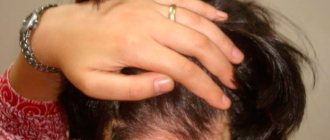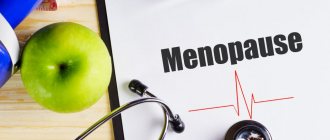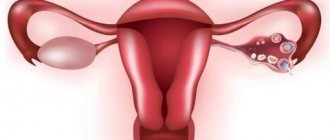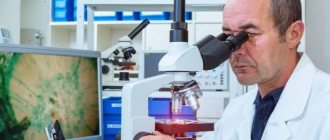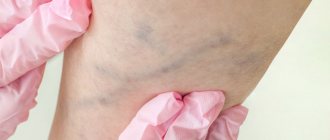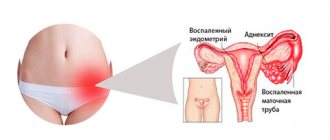Seborrheic dermatitis is an inflammation of the skin as a result of increased secretion of qualitatively altered sebum and the active influence of microbial agents - Pitirosporum orbiculare and Pityrosporum ovale - opportunistic fungi from the genus Malassezia. Skin densely populated with sebaceous glands is susceptible to such damage, namely, the face (forehead, chin, nose, naso-cheek folds), scalp skin, chest (midline area), back (interscapular area), and ear area.
It has been noted that the activity of these opportunistic fungi increases under unfavorable conditions, such as:
- immune and endocrine disorders;
- stress;
- various lesions of the nervous system.
It is known that opportunistic fungi from the genus Malassezia concentrate around the mouth of the sebaceous glands in order to produce fatty acids that abundantly saturate the sebaceous secretion. Thus, seborrhea - a change in the quality and quantity of sebum, contributes to the hyperactivation of fungal microflora: Pityrosporum ovale, parasitizing mainly on the skin of the scalp and Pityrosporum orbiculare, tropic to the sebaceous glands of the chest and back.
Unfavorable factors for intensifying the pathological process are:
- irritating effect of alkaline detergents;
- excessive sweating;
- winter season.
Features of the disease
The disease can develop in a person of any age, starting from infancy. Mostly observed in adolescents and young adults, after 40 years it occurs much less frequently. Men develop the disease much more often than women. This is explained by the fact that an increase in the amount of secretion from the sebaceous glands (sebum) is influenced by an increased level of male sex hormones testosterone and dihydrotestosterone.
The causative agent of seborrheic dermatitis is considered to be opportunistic microorganisms of the genus Malassezia – Malassezia globossa and Malassezia restricta. These are yeast-like fungi that live on the skin of 80% of people and are part of the body's microflora. However, under certain conditions (decreased immunity, hormonal imbalance), they begin to actively multiply, resulting in peeling, and in some cases it is complemented by inflammation.
This is interesting! This genus of fungi received the name Malassezia after the name of the microbiologist who discovered them, the French scientist L. Malassez.
Sebaceous glands are usually concentrated around the hair follicles, but in some areas of the body the sebaceous glands are not located near the hair follicles - for example, on the ears. Fatty secretion is necessary to lubricate the skin and hair: it creates a film on their surface that protects them from the adverse effects of the environment.
How the disease develops
The development of the disease occurs as follows. The human sebaceous glands produce a secretion rich in fatty acids. Malassezia fungi, living next to the sebaceous glands, “feed” on this secretion. When processing it, they release fatty acids that irritate human skin and destroy the protective barrier, as well as making oleic acid, which is part of sebum, toxic.
Normally, regeneration (exfoliation of dead cells and formation of new ones) of the epidermis, the outermost layer of skin, occurs in about a month. Fungal activity accelerates this process. As a result, the skin begins to peel off severely.
The location of the sebaceous glands on the skin varies. In some areas there are more of them, in others there are fewer, in some they are completely absent. The disease develops most often in those places where there are the most sebaceous glands and hair follicles. The most common type of pathology is seborrheic dermatitis on the scalp, on its scalp. The disease can also often affect the face:
- nasolabial triangle;
- forehead;
- wings of the nose;
- ears and areas behind the ears;
- eyebrows and eyebrows;
- cheekbones;
- mustache and beard.
On the body, seborrheic dermatitis is localized in the following areas:
- External genitalia.
- Forearms.
- In the armpits.
- Navel.
- Breasts.
- Areas between the shoulder blades.
Sebaceous glands are completely absent on the knees and feet. Therefore, the disease does not develop on them.
Seborrheic dermatitis may be accompanied by sebostasis. This is what is called stagnation of secretions in the sebaceous glands. This pathology can lead to the development of infection and purulent processes.
Types of seborrheic dermatitis
The disease can be congenital or acquired.
The congenital form is rare. In this case, the child has increased secretion of the sebaceous glands from birth. This disease is incurable. Typically, seborrheic dermatitis is an acquired pathology.
In form, depending on the activity of the sebaceous glands, seborrheic dermatitis is:
- dry;
- bold;
- mixed.
In the dry form, not enough oily secretion is released. The skin dries out and cracks. With dry seborrheic dermatitis, there are no foci of acute inflammation. It is characterized by the presence of an abundance of fine dry dandruff on the scalp. This type of disease is most often observed in adolescents.
In the oily form, an excessive amount of thick secretion is released from the fat glands, gluing the flakes of exfoliating skin. Hair takes on an unkempt, greasy appearance. The skin becomes too oily. This type of disease is typical for young women.
The mixed form is characterized by the presence of foci of oily and dry dermatitis in different parts of the body and head. Most often this type occurs in men.
Salon procedures for the treatment of seborrhea
The Apriori salon chain offers the services of highly qualified hairdressers, cosmetologists, dermatologists, manicurists and pedicurists, stylists, makeup artists, and image makers. Our priority is the beauty and health of our clients, so we provide assistance with various skin problems. Seborrhea on the face is an unpleasant defect, but you can get rid of it. To do this, our salon uses the following methods:
Restoring the functions of the sebaceous glands using the Darsonval apparatus. Thanks to this procedure, the inflammatory process is eliminated, the cells receive enough oxygen to begin regeneration of the epidermis. Exposure to microcurrents is painless and does not pose any danger. During the session, only a slight tingling sensation may occur, which quickly passes.
Facial mesotherapy is the second effective technique that not only helps to improve skin health, but also has rejuvenating properties. Therapeutic combinations of drugs are selected in such a way as to ensure maximum results without causing harm. 10 sessions are enough for the defect to be eliminated.
Even if you do not have problems with skin or hair, we invite you to procedures for preventive purposes. Apriori specialists will recommend the best methods, selected specifically for each client, so the result will completely satisfy you.
Reasons for the development of the disease
There are three main causes of seborrheic dermatitis:
- Immune. Weakening of the immune system is observed with systemic and infectious diseases, lack of vitamins and microelements in the body, poor nutrition and a sedentary lifestyle. With a decrease in immunity, any concomitant factor can cause the immediate development of seborrheic dermatitis.;
- Hormonal. Hormonal causes include pathologies of the internal secretion organs (adrenal glands, thyroid gland, ovaries) and other conditions in which hormonal imbalance occurs. Hormones are also responsible for the secretion of the sebaceous glands. Therefore, with an excess of some of them, increased sebum production occurs. Seborrheic dermatitis is often observed during puberty, when hormonal changes in the body occur.;
- Neurogenic. The activity of the sebaceous glands is also influenced by the central nervous system. It controls the autonomic system, which is responsible for the level of sebum production. Therefore, seborrheic dermatitis is often observed in diseases of the nervous system (manic-depressive psychosis, schizophrenia, encephalitis, paralysis, Parkinson's disease).
Concomitant factors that “trigger” the development of the disease include:
- stress;
- failure to comply with personal hygiene rules;
- overweight;
- disorders of the gastrointestinal tract;
- abuse of sweet, spicy, salty foods;
- use of cosmetics that irritate the skin;
- physical inactivity (sedentary lifestyle);
- taking antidepressants, hormones, psychotropic drugs;
- hyperhidrosis (increased sweating);
- sudden climate change.
Patients at risk are:
- With immunodeficiency conditions (HIV, AIDS).
- With diseases of the gastrointestinal tract.
- Subject to frequent stress.
- With a hereditary predisposition.
In infants, seborrheic dermatitis occurs when there is an increased content of hormones in breast milk. As a rule, after the end of the breastfeeding period, the symptoms of the disease disappear.
Signs of seborrheic dermatitis
Symptoms of pathology begin to appear if the number of Malassezia fungi exceeds 50% of the total microflora (below 50% is normal). In this case, approximately every patient develops dandruff - a harbinger of the disease. When the concentration of fungi increases to 80% or more, seborrheic dermatitis itself develops.
Its main symptoms:
- Redness of the skin;
- Itching and soreness;
- Peeling - small or large scales.
Other symptoms may also appear on the skin:
- Yellowish-reddish spots.
- Papules (reddish lumps).
- Groups of bubbles.
- Cracks.
- Large plaques with clear outlines.
- Thickening of the stratum corneum of the skin.
- Dense crusts on the scalp.
Mixed seborrhea
Mixed seborrhea has characteristics of dry and oily varieties. In particular, patients note that the skin on the face in the middle part is oily, and on the cheeks it is dry. Especially a lot of fat is released in the areas of the crown, chin, forehead, and nose. In other places the fat content is moderate or insufficient.
Doctors also note that a person may be bothered by dry dandruff and oily skin on the face.
Symptoms of mixed seborrhea:
- inflammatory process on the cheeks, scalp, chin, forehead, chest, nose;
- in the area of inflammation, the skin becomes rough;
- redness, itching;
- increased secretion of sebum on the forehead, but decreased secretion in other areas of the face;
- peeling in the area of increased activity of fat-secreting glands, yellowish or gray scales;
- peeling of dry areas of skin.
All the factors listed above as causes of other types of the disease can provoke mixed seborrhea. Most often the problem is associated with hormonal changes or disruptions. Heredity plays an important role. Stress and anxiety can also contribute to the growth of fungi.
Complications of the disease
It is important to begin treatment of seborrheic dermatitis as early as possible, since as it progresses, complications may arise:
- Acne.
- Abscesses.
- Seborrheic eczema.
- Alopecia (baldness).
- Streptoderma (infectious skin disease).
- Pyoderma is a purulent skin lesion.
It is especially dangerous to develop seborrheic dermatitis on the face, close to the ears or head, as it often causes the development of conjunctivitis, blepharitis (inflammation of the eyelids), and otitis media.
Photo
In order to consolidate information about the symptoms of each type of pathology, and to understand what seborrhea looks like on the face, a photo will come in handy.
Photo of dry seborrhea on the skin of the face, the causes and treatment of which may be different.
At the same time, a photo of the initial stage of seborrhea on the face proves the unclear symptoms of the onset of the pathology.
Photos of oily seborrhea of the face cannot be confused with anything.
An image of the combined type of pathology confirms its name - signs of both types are present.
Diagnosis of the disease
To make a diagnosis you need:
- Examination by a dermatologist, trichologist.
- Differential diagnosis with psoriasis, atopic dermatitis, lichen and other diseases with a similar clinical picture.
- Dermatoscopy is an examination of the skin under a microscope.
- Blood tests: general, biochemical, hormones, sugar.
Additionally you may need:
- Coprogram.
- Analysis of stool for dysbacteriosis.
- Ultrasound of the thyroid gland, abdominal cavity.
- Trichogramma.
Treatment of seborrheic dermatitis
Treatment methods:
- Prescription of local and systemic antibacterial, antifungal, anti-inflammatory, antihistamine drugs.
- Taking vitamins.
- The use of medicinal cosmetics (ointments, creams, shampoos) for the skin of the face, body and scalp.
- Special diet.
Diet is an important part of treatment, since improper nutrition provokes exacerbation of skin diseases. It involves avoiding spicy, starchy, fried, sweet, smoked and salty foods. Alcohol is also excluded.
It is recommended to eat fruits and vegetables, boiled lean meat, and dairy products. It is important to include in your diet foods rich in vitamins A, C and B, selenium, and zinc.
At the Otradnoe Polyclinic you can make an appointment with a dermatologist at any time convenient for you, without queues. The doctor will determine the cause of the disease and prescribe individual treatment, thanks to which you will soon return to your normal lifestyle.
Tubular seborrhea
This is a special type of seborrhea, the main symptom of which is the formation of scales not on the scalp, but on the hair. This is explained by the fact that the active reproduction of the Malassezia fungus began precisely on the hairline. Dandruff looks like small tubes, which are sometimes confused with nits.
Tubular seborrhea is also characterized by severe itching and redness. Most often it occurs in adolescence, when hormonal levels are actively restructured.
Also, the causes of tubular dandruff can be:
- lack of vitamins;
- metabolic disease;
- improper or insufficient hygiene;
- improper or poor nutrition, diets;
- physical and emotional stress;
- skin diseases;
- chronic illnesses, hepatitis, HIV and other diseases that reduce immunity.
